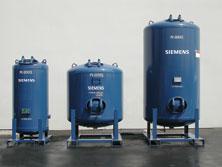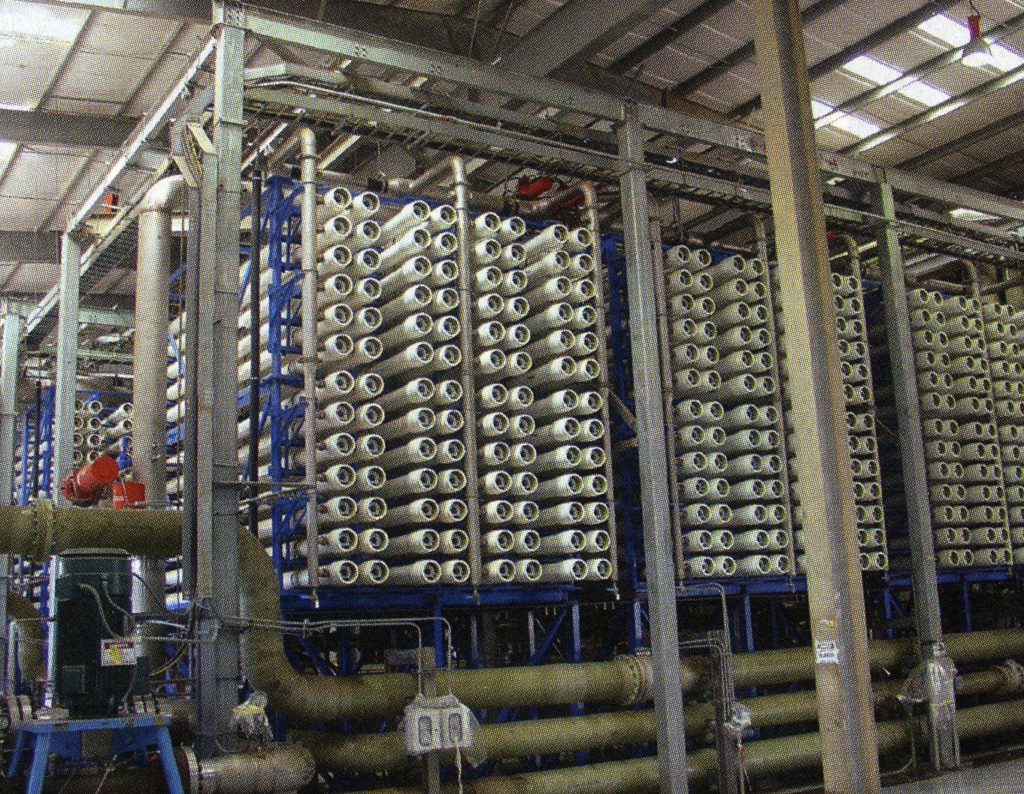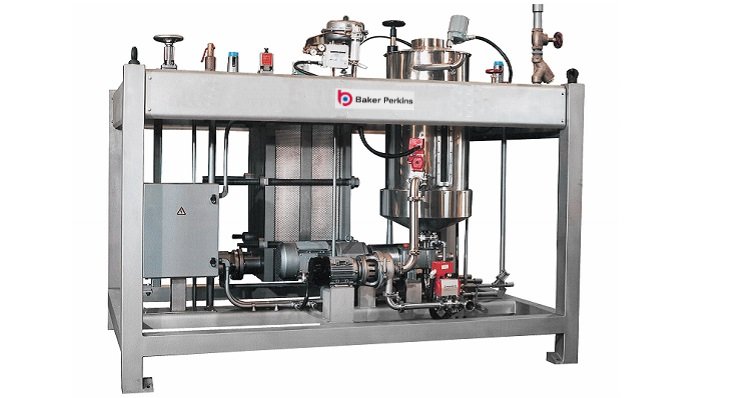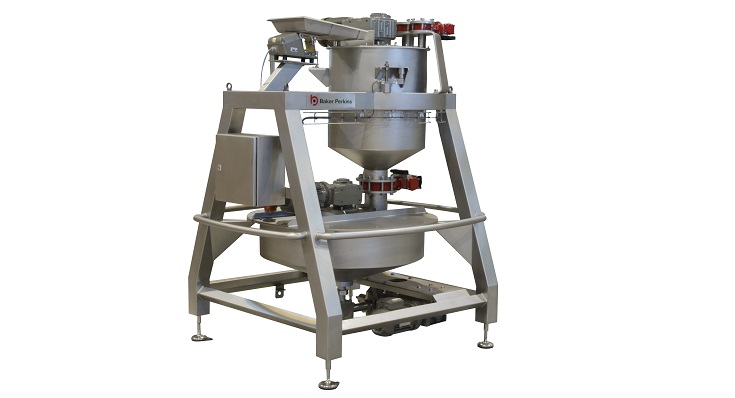Sugar confectioneries, better known as hard candies, are mixtures of sucrose, fructose, glucose, or maltose syrups, which are kept in an amorphous or glassy state, and can contain different flavors and colorings. Hard candies are prepared by boiling one or more sugar-based syrups to a temperature of 160°C (320°F) and then formed and cooled to room temperature.
The production of candy first began in the 17th century as sugar was becoming more popular. By the late 1800s, the mass production of sweets in large factories had begun. Today, nearly 600 million pounds of candy are purchased annually in the United States alone.
Hard candy manufacturing and production consist of the following unit operations: preparation of ingredients, and production and preservation of candy. Production includes dissolving and boiling the mixture and packaging the candy. The following sections describe these unit operations along with the specific equipment used in each operation.
Ingredient Preparation
Hard candy is primarily made of fructose and glucose syrups mixed with purified water, flavorings, and colorings. Each ingredient needs to be prepared and heated according to the specifications for the desired product, before being mixed together. Hard candy ingredient preparation includes water purification and the heating and dissolving of different types of sugars, primarily sucrose (table sugar) and glucose.
Preparation of Sugars
Other ingredients in hard candy include high fructose syrups and glucose syrups, which are prepared by converting corn starch to glucose and fructose. This is achieved by using enzymes that break the long starch chains into the monomers glucose and fructose. The corn starch is added to water and enzymes in a vat and mixed to a slurry, while the enzyme breaks down the starch. The two types of sugar are then separated and blended to a specific ratio to ensure uniformity of taste.
Preparation of Flavorings
In addition to sugar syrups, hard candy contains natural and artificial flavorings and malic or citric acid. Flavorings are used to add characteristic flavor and typically include combinations of fruit juice flavors, essential oils, and/or oleoresin, which are a mixture of resins and essential oils. More detail can be found on oleoresins in the spices and extracts module. Malic acid, which gives that tart taste to apples, is used to enhance non-citrus flavors, and citric acid promotes the flavor of the citrus-based flavored candies and cuts excessive sweetness. Additionally, colorants are used to increase visual appeal. Some different variations of hard candy are found below.
Water Purification
Contaminants in the water used to make candy may affect the odor, taste, color, or appearance of the final product, so the water must be purified to remove microbial contamination, organic and inorganic compounds, and other particulate matter. The main way to purify water is through chemical treatment, starting with the addition of chlorine to disinfect the water. Oxidizing agents are further added to oxidize impurities in the water, and chemical lime is then added to remove metal cations, a step referred to as “softening” the water. To remove products formed by the previous chemical additions, sulfate salts are added to precipitate out the products. This operation, known as coagulation, is carried out in a reaction tank where settled precipitates can be removed from the bottom of the tank. After precipitates are removed, the water passes through an adsorber, shown below, to remove chlorine and organic compounds. The treatment step concludes with a final filtration step before the water is used in further production.
Common unit operations used to treat water include reverse osmosis, ultrafiltration, and ion exchange. In a reverse osmosis system, shown below, the municipal feed water is pumped through a semipermeable membrane that particulate matter and microbial life cannot pass through.
Additionally, the membrane is electrically charged so that dissolved ions and organic material are retained on the feed side of the membrane. The water passing through the membrane is free of contaminants and can be used in further production. During ultrafiltration, feed water passes through a semipermeable membrane to remove macromolecules, microbial life, and particulate matter. Additionally, ion exchange columns can be used to remove cations and anions from municipal water.
Production
Hard candy production consists of preparing the syrup mixture, cooking the mixture, and bringing the sugar mass to the right consistency and shape before packaging.
Mixing
First, the dry and liquid confectionery ingredients are weighed and mixed into a homogeneous slurry using an auto-feed system or batch dissolver, as shown below.
(Copyright Baker Perkins Ltd, Peterborough, United Kingdom)
Individual ingredients are fed sequentially from a bulk handling system into a weighing and mixing tank mounted on load cells at each support. Weighing eliminates the errors that can occur in volumetric systems due to variations in temperature, density, and viscosity.
Cooking
After mixing, a microfilm cooker, shown below, is used to cook the slurry rapidly and create the final product. The process is continuous and cooks the mixture in two stages.
First, the sugar slurries are mixed, and then cooked and converted to a product with the proper moisture content. The continuous process produces very little waste and is efficient in its use of energy and water. A pressure-dissolving system reduces recipe water, which permits higher temperatures and increases saturation levels of sugar. The increase in saturation means there is less water to evaporate, so less energy is needed to evaporate water from the mixture.
After cooking the candy, the mixture is mixed with other ingredients such as flavorings, acids, and colorings. The mixture is then cooled and tempered to a temperature suitable to feed into a batch former.
Cooling/Forming of Candy
The mixing and cooling operation can be done in a batch kneader and continuous cooling/tempering band respectively. The continuous cooling band is made of stainless steel and has a framework made of steel tubing and a water-cooling system. The sugar mass is cooled in the belt by the cold-water system and the temperature is controlled by a thermostat. For the batch kneader unit, the sugar mass is kneaded and plowed above a steel belt, which accelerates heat transfer and changes the sugar to the right consistency.
After the sugar mass reaches the right consistency, it is fed to a batch former, that shapes the cooled and tempered sugar mass into a cone to feed to a rope sizer. The former is equipped with a heating system to keep the sugar mass at an appropriate temperature to prevent cracking or very viscous behavior.
The rope sizer then sizes and delivers the sugar mass at a specific diameter to the candy maker machine. Additionally, an electric heater is used within the rope sizer to keep the sugar rope in the perfect plastic condition. The rope sizer acts as the connection between the batch former and the candy maker.
The candy maker or candy shaping machine is followed by the cooling and wrapping equipment. Hard candies, specifically, are made by a hard candy maker that contains rotary dies suitable for any shape or size of candy. The candy maker is a highly efficient automatic machine that consists of a cast frame, sizing unit, rotary die, candy discharge belt, and control system.
The cast frame provides a strong foundation used to absorb all vibrations from candy embossing and shaping. The sizing unit is composed of two sizing rollers that are used to obtain the desired sugar rope diameter. The candy shaping unit is a continuous, automatic, multi-position process, in which the unfilled sugar rope obtained from the rope sizer is squeezed and separated into multiple sections. In this unit, a piece of sugar mass is cut off and shaped using a roller and toothed ring and is subsequently put on a die plate. A scraper is used to prevent fine sugar pieces from sticking to the die plate and causing the next shaping process to malfunction. The sugar mass can also be shaped using a candy depositor. The depositing process allows the cooked sugar to be fed directly to the candy depositor, which places it into individual candy molds. This can be seen in this video.
The molds are then fed into a cooling tunnel that hardens the cooked candy, which are then fed to the candy ejector. The overall depositing process can be seen below.
Packaging and Quality Control
Candy formed by either the depositor or candy shaping machine is then packaged in a high-speed wrapper or enrobing machine. Quality control throughout the process is achieved by controlling the temperature and water content of the sugar during production to ensure it keeps its plastic characteristics. Quality and purity of water are also maintained to ensure proper sanitation and ingredient preparation, as described above.
Acknowledgments
- Baker Perkins Ltd, Peterborough, United Kingdom
- Chemical Engineering, Access Intelligence, LLC
- Water Technologies Business Unit of Siemens Industry, Inc., Warrendale, PA
- Hard Candy.jpeg, Adam Zivner, Wikimedia
References
- Farkas, Daniel F. “Food Processing.” Kirk-Othmer Encyclopedia of Chemical Technology (2015): Wiley Online Library. Web.
- Margaret Gilligan, Personal Communications, 2017.
- 24, Studio. “Confectionery Cooking.” Confectionery Cooking | Baker Perkins, www.bakerperkins.com/confectionery/equipment/confectionery-cooking/
- Steen, David P., and P.R Ashurst. Carbonated Soft Drinks: Formulation and Manufacture. Ames, IA: Blackwell Pub, 2006. Print.
Developers
- Ellen Khoury
- Daniel Watza
- Austin Potter








